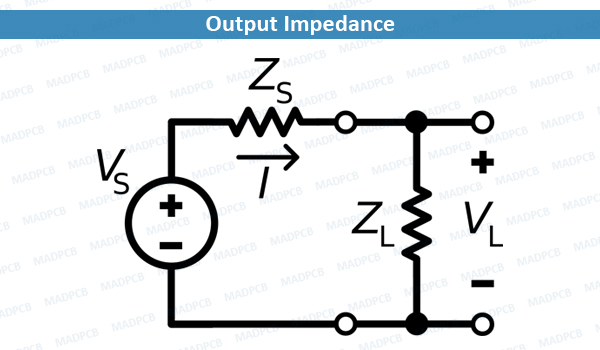Output Impedance is the ratio of change in output voltage to change in load current. All devices and connections have non-zero resistance and reactance, and therefore no device can be a perfect source. Power supply input and output impedance are used to verify the supply’s stability and dynamic performance when subjected to various loads.

Output Impedance
It is what is seen when looking into the power supply circuitry from the output end. The output impedance depends on whether it is used as a voltage source which ideally has zero impedance, or as a current source which has infinite or very high impedance. Low impedance in a voltage source is usually preferred because it helps to keep out the noise out of the circuit and maintain a stable output voltage.
A typical power supply acts as an ideal power supply with a series resistor connected in series with its output. There is no source of power which is perfect and there is always some drop in output voltage when a load is connected.
The output voltage of the supply at no load will remain constant until a load is connected and the current starts flowing. The voltage drop at the output is dependent on the output current as well as the impedance. This impedance is often affected by the components at the output regulator and filter stage of the power supply, and largely influenced by the capacitors and inductors.
Impacts of Power Supply Output Impedance
An ideal constant voltage power supply should have zero impedance so that changes in the load such as higher load currents do not cause a voltage drop at the output. In addition, the low impedance helps in reducing the noise and interference. When the supply has high impedance, high load current causes a voltage drop across this impedance and lower the output voltage.
Voltage drops at the output are undesirable since the voltage will sometimes go out of regulation and especially when the output current is high. Of concern is when the high impedance causes greater voltage drops when low impedance loads are connected. This can be large enough to prevent the load from getting sufficient power to operate properly.
The impedance of a power supply impacts on the conducted interference and especially in loads with mixed signal circuits. Care should be taken to ensure that transient response of power conditioners and power sources does not lead to voltage swings beyond the load’s operating voltage tolerance rating.
In high-speed digital circuits that require clean power, the processors and FPGAs may draw very high currents that can destabilize the power supply. The high current lasting only a few nanoseconds may be as a high as tens of amperes and the power supply is expected to remain stable when this occurs. There should be no under-shooting or over-shooting, ringing or any other response that will cause the circuit to misbehave.
Source Impedance and Load Impendence Matching
The maximum power transfer from a source to a load is usually achieved when the load impedance matches the source impedance.
RL = Ri or ZL = Zg
Where Ri = Zg is the output impedance or internal resistance of the supply
RL or ZL is the load resistance or impedance
Finding a reliable quick-turn impedance-controlled PCB manufacturer? Try MADPCB.
Feedback in Power Supplies
The impedance of a voltage source converter is typically in the order of an ohm to several ohms and is referred to as the open-loop impedance, since it refers to the output impedance without any feedback applied at the output.
However, it is a factor of the feedback loop and the regulated power supply works more or less like an amplifier with feedback. And the same principles that apply to the feedback design in amplifiers are similar to that in the regulated power supply. The effectiveness of power supply regulation is dependent on the magnitude and frequency variations in the load, and the low impedance helps maintain a stable output regardless of these changes.
A high quality, constant voltage power supply usually has a low output impedance, and properly controlled reactive elements so as to provide a clean, stable and well-regulated output power.
